
Centre of Jaina Studies Newsletter: SOAS - University of London
In one trip to Mysore and Śravaṇabeḷagoḷa delegates and participants had the unique experience of witnessing five functions in grand Indian style. The first was a three-day international conference on 'Jainism through the Ages' held from 8-10 October 2010 at the Daśara Exhibition Complex in Mysore, organised by the Directorate of Archaeology and Museums (Mysore) and the Bhāratavarṣīya Digambara Jaina Tīrthakṣetra Committee (Mysore). This was followed by a special day-trip to the Kanakagiri Siddhakṣetra on 11 October, and then a threeday international Prakrit seminar on 'Universal Values of Ancient Prakrit Texts' from 1214 October 2010 in Śravaṇabelagoḷa, organised by the Bāhubali Prākrita Vidyāpīṭha in collaboration with Rāṣṭrīya Saṃskrita Saṃsthāna. This culminated in the Prākṛta Jñānabhārati International Award Function for three scholars on 14 October 2010. Lastly there was a book release in Bangalore on 15 October 2010 of Svasti. Essays in Honour of Prof. Hampa Nagarajaiah edited by Prof Nalini Balbir.
Jainism through the AgesThe opening was a grand one with dance and music under a huge canopy, next to the conference rooms in the Exhibition Complex of Mysore. The conference president was Professor Nagarajaiah Hampa (Hampana). There were so many delegates that three parallel sessions were planned and although the rooms were nearby, it was unavoidable that many of us could not listen to several interesting and informative presentations. The chairpersons of each session had to be strict with the timing: most papers were just ten minutes' long, with a few twenty minutes' long on the first day. Dr R. Gopal, the Director of Archaeology and Museums (Mysore) and the representatives of Digambar Jain Tīrthakṣetra Committee (Mysore), Professor Nalin Shastri, Charakesh Jain and Vinod Bakliwala, saw to it that all participants received excellent care. Buses were organised to bring us from the hotel to the conference centre every morning, where we started with breakfast; coffee and tea breaks with snacks added to the enjoyment of the talks, with lunch and dinner at regular times. Indeed, food for thought was well-supplemented by excellent South Indian Jaina food.
Not all delegates announced in the original circular were able to attend, including several foreign delegates. Hence, the Abstracts, with the titles of papers to be presented, which was distributed to all participants, had to be consulted with great care. Further, only a brief report can be made here of but a few of several papers actually heard by this writer. There were several excellent presentations, especially on inscriptions, archaeology, temple renovation and restoration. Gopal Rao H. S. of Bangalore, for example, made an impressive presentation on 'Basadis in the Bangalore Rural Districts', making it evident that there still are several temples yet to be discovered. Moreover, he indicated that the task is urgent to make a concerted effort to look for them if such Jaina masterpieces are to be rescued from destruction, and possible theft of the icons installed in them. Professor Kamala Hampana provided some thoughtful reflections on 'Abhiṣeka and Tīrthas'. R.P. Poddar's 'Jaina Concept of Origin and Transmission of Speech (Bhāṣā)' was based on the eleventh chapter of the Paṇṇavaṇasutta where Mahāvīra answers questions put by Gautama Gaṇadhara about the origin and transmission of speech. Professor Prem Suman Jain, now of Śravaṇabeḷagoḷa, spoke on 'Some Symbolic Narratives in Jainism' with the aim of showing how one can derive valuable information from Jaina narrative literature about aspects pertaining to economic life, arts and crafts, educative material on ethics, polity and other matters about the cultural heritage and history of India.
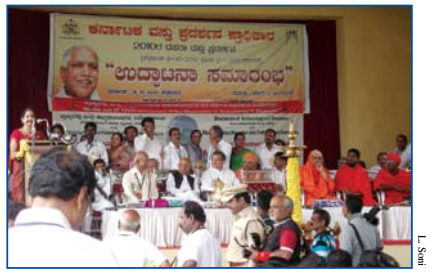
Grand opening of 'Jainism through the Ages'
Kanakagiri SiddhakṣetraAfter the Mysore conference a special trip was arranged on 11 October 2010 to the holy hill in Kanakagiri, situated near Maleyur in the Chamarajanagar district of Karnataka. The pamphlet of the place says that many inscriptions and records suggest that a Bhaṭṭāraka seat was in existence there since the twelfth century CE. The hill was an important Jaina centre in very early times, with reference having been made to it in ancient Jaina works. The well-known commentator of Umāsvāti's Tattvārthasūtra, Pūjyapāda (fifth or sixth century) with his Sarvārthasiddhi is said to have chosen it as his sacred abode and to have undertaken severe penances there. It was through his inspiration that footprints of the 24 Jinas were installed on the hill. It is now a pilgrimage centre and the inscriptions, engravings of footprints, samādhi maṇḍapas, niṣadi caves and other monuments bear witness to the rich heritage of the place.
The visitors were welcomed by the present bhaṭṭāraka Bhuvana Kīrti Svāmī with music and a procession to the building, preceded by a garland welcome. The usual Indian hospitality was accorded in a very unassuming way. We were all provided with breakfast, lunch and delicious fresh coconut water, which was most welcomed after the climb to the holy hill. We were given an interesting and lively talk in Hindi about the hill and anecdotes about Pūjyapāda by Svāmījī. It would be a worthwhile project to gather all available information about Pūjyapāda.[1] We left after lunch for Śravaṇabeḷagoḷa.
Universal Values of Ancient Prakrit Texts
This was a three-day international Prakrit seminar which took place from 1214 October 2010 in Śravaṇabeḷagoḷa, organised by the Bāhubali Prākṛta Vidyāpīṭha in collaboration with the Rāṣṭrīya Saṃskrita Saṃsthāna. The inaugural session started at 11.30 on the 12th with a speech by Professor R. V. Tripathi, the Vice-Chancellor of Saṃskrita Saṃsthāna in New Delhi. He highlighted the significance of Prakrit and how necessary it is even for Sanskrit studies, especially since great poets like Kālidāsa were proficient in that language. The keynote address was given by Bhaṭṭāraka Svāmī Cārukīrti, founder president of the Bāhubali Prākṛta Vidyāpīṭha in Śravaṇabeḷagoḷa and head of the Jaina Maṭha there. He called for the founding of a Prakrit university which would be an advancement on the already well-established Bāhubali Prākṛta Vidyāpīṭha.
The conference was organised in a way that enabled everyone to listen to all the talks because there were no parallel sessions, a fact that many of us appreciated very much. It was also a delight to listen to many presentations with numerous quotations in Prakrit, which were then explained. In fact, two papers were delivered entirely in Prakrit, giving clear evidence of excellent training. In a few cases, we also overheard short conversations in the language. Whilst the Prakrit of the canonical literature was a common theme, there were also several references to and a few papers on the use of Prakrit for technical subjects like philosophy, as exemplified in the use of it especially by Kundakunda. In this context Professor D. N. Bhargava's paper on the Samayasāra and Dr Nalini Joshis's on the Pañcāstikāya need special note.
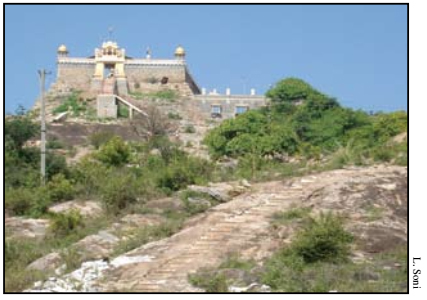
Short climb to Kanakagiri Siddhakṣetra
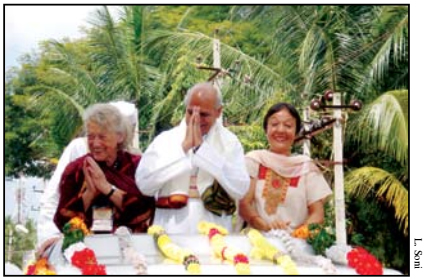
Prize-winner-mobile: Professors Adelheid Mette, Rajaram Jain and Nalini Balbir
At a session designated for suggestions there was a discussion about founding a Prakrit University and Cārukīrti Bhaṭṭāraka Svāmi made a very strong case for it. The State Government will be urged to establish such an institution. Moreover, there was also a suggestion to organise a World Prakrit Conference (WPC). It was decided to build a working committee for this and to weigh the possibility of holding it towards the end of 2011. The month under consideration was November, with a great deal of flexibility about where it should be held, not necessarily in Śravaṇabeḷagoḷa. The highlight of the conference was the valedictory function on the last day, 14 October 2010.
The Prākṛta Jñānabhāratī International Award
This award was first instituted in 2004 by the Bāhubali Prākṛta Vidyāpīṭha and the National Institute of Prakrit Studies and Research, Śravaṇabeḷagoḷa, on the advice and guidance of Bhaṭṭāraka Cārukīrti Svāmī. This award with a citation and a memento goes together with a cash prize of one hundred and fifty-one thousand Rupees. It is awarded 'to an eminent scholar of international recognition for his/her outstanding and meritorious service to the promotion and resumption of Prakrit and Jaina Studies'. The first to obtain this annual award was Professor Padmanabh S. Jaini in 2004. The second and third were awarded to Professor Willem Bollée and Professor Klaus Bruhn at a function in Berlin in 2008. The awards for 20072009 were held conjointly at Śravaṇabeḷagoḷa on 14 October 2010, the last day of the three-day international Prakrit seminar. The prize was awarded respectively to Professors Rajaram Jain of Noida (2007), Nalini Balbir of Paris (2008) and Adelheid Mette of Munich (2009). It was an unforgettable experience for those of us who had the privilege and honour of being there. After a short pūjā at the foothill of Candragiri in Śravaṇabeḷagoḷa, to which we all walked, the awardees boarded an open-air beautifully flower-decorated 'prize-winner-mobile' and proceeded to the accompaniment of music and drums to the hall to receive their prizes. Justice Ajit Kabbin of the Karnataka Administrative Tribunal was the honoured guest who was asked to present the awards together with Cārukīrti Bhaṭṭāraka Svāmī. The procession took about half an hour from Candragiri and each awardee was then called upon to receive the prize sitting on a 'throne' under umbrella carriers. Truly a sight to witness! Naturally the presentation of the three awards was accompanied by an initial invocation, welcoming speech and then garlanding each person concerned. Professor Prem Suman Jain in his vote of thanks was rightly obliged to all those who made the conference and the valedictory function a great success. After lunch at about two o' clock delegates and participants said their goodbyes and proceeded either to their homes or to Bangalore from Śravaṇabeḷagoḷa for the next function.
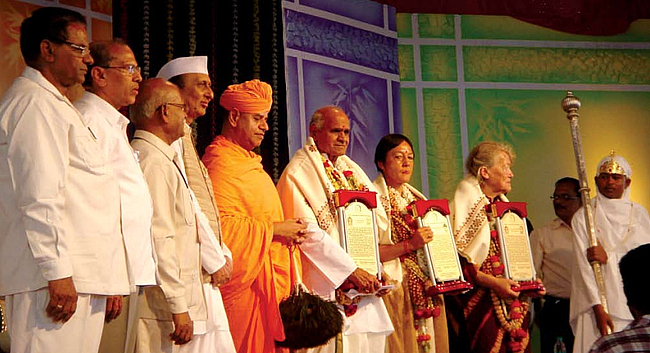
On the Stage: Prem Suman Jain, M. J. Indrakumar, Hampa Nagarajaiah, Ajith Kabbina, Bhaṭṭāraka Cārukīrti Svāmī, Rajaram Jain, Nalini Balbir and Adelheid Mette. Photo: courtesy of Ms Ratna Sagar
Svasti. Essays in Honour of Prof. Hampa Nagarajaiah Edited by Prof Nalini Balbir
The book release on 15th October 2010 was no less spectacular, with even the Chief Minister of Karnataka and several State dignitaries taking part. The book is divided into five sections: Epigraphy, Iconography, Manuscripts (eleven articles); Literature (five articles); Kundakunda and his Legacy (three articles); General Issues (eight articles); and Facets of Contemporary Jainism (six articles) for a total of thirty-three articles, with forty separate pages of plates, many containing two a page. The book has been published by Dr M. Byregowda for Muddushree Granthamale in Bengaluru (www. ksmtrustwordpress.com, [email protected]). This is a mere announcement of the new publication, a review of which will have to be undertaken on another occasion.
All in all, these five functions in one trip to South India were unique experiences and participants undoubtedly returned all the more richer for the experience. The writer appreciates the opportunity to thank all those involved in their organisation, and especially for their hospitality, generosity and kindness.
Jayandra Soni is a lecturer at Philipps University, Marburg, Department of Indology und Tibetology. His research interests centre on Indian philosophy, especially Jaina philosophy.
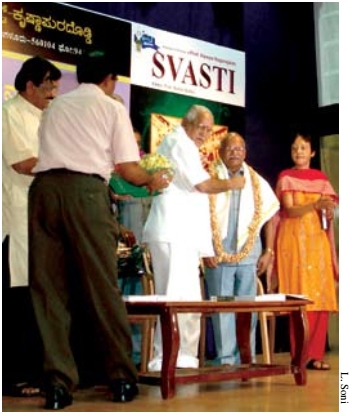
Book Release
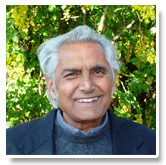 Dr. Jayandra Soni
Dr. Jayandra Soni